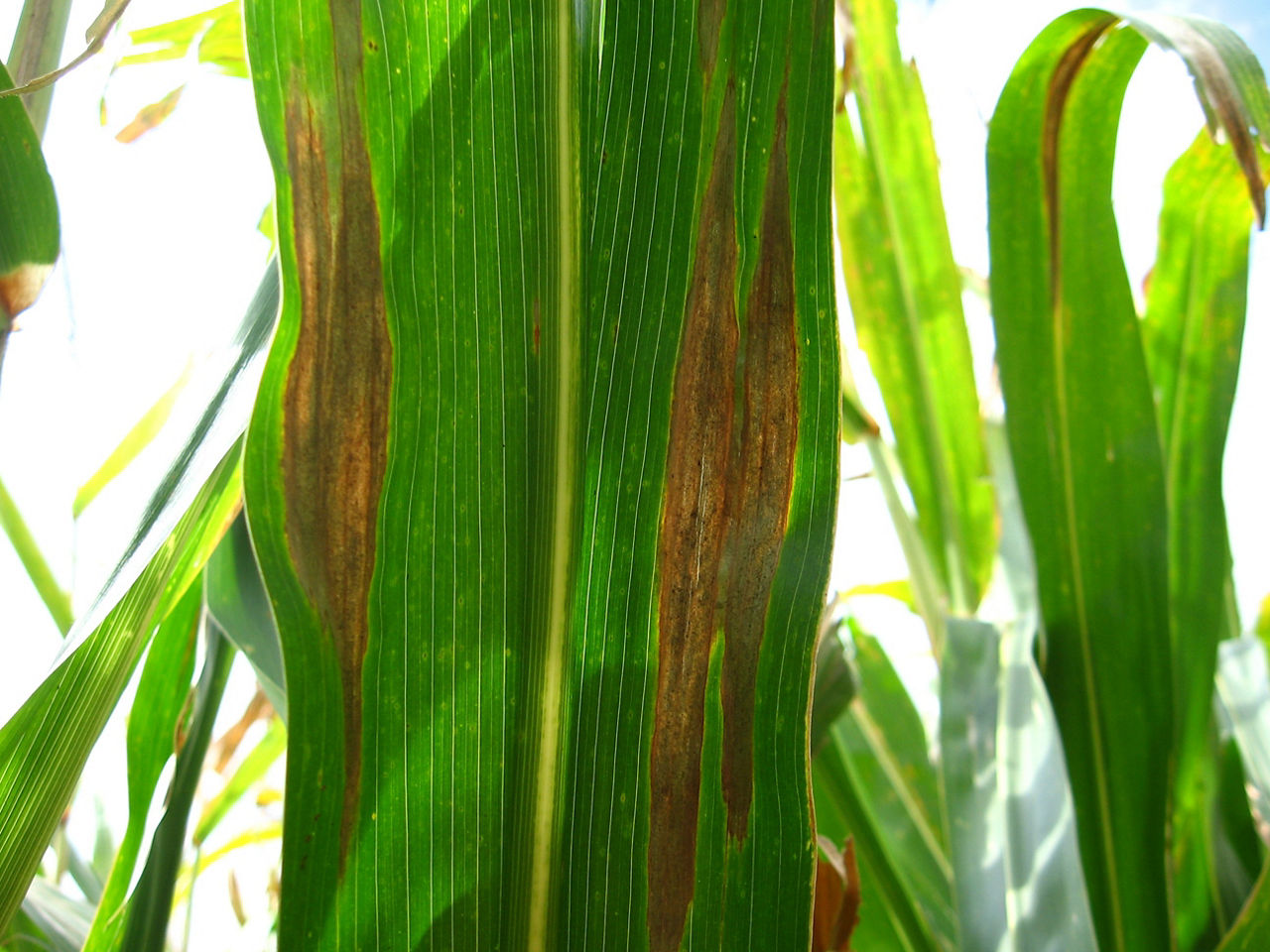3 MIN READ
Managing Northern Corn Leaf Blight
July 26, 2023
Disease Cycle
There are multiple races of the fungal pathogen Exserohilum turcicum, which can cause northern corn leaf blight (NCLB). This fungus overwinters on previously infected corn residue as conidia and mycelia. Conidia are external spores, and mycelia are the rootlike structure of a fungus. During the warm, moist weather of early summer, new conidia are produced on the residue from the previous corn crop. Conidia can be produced abundantly on lesions of susceptible plants and may be responsible for secondary spread within and between fields, as wind and rain can spread the conidia onto the lower leaves of young corn plants.
Development of the disease is favored by heavy dew, frequent rainfall, high humidity, and moderate temperatures. The infection process begins when water is present on the leaf surface for 6 to 18 hours while the temperature is between 65° and 80 °F (18° and 27° C).1 When conditions are favorable, lesions can develop and new spores can be produced within 7 to 12 days on susceptible corn products. These conditions may result in a rapid spread of disease symptoms.2 However, hot, dry weather can restrict the development of the disease.
Symptoms and Severity
NCLB lesions are typically gray-green to tan colored, elliptical or cigar shaped, and one to six inches in length (Figure 1).2 As lesions mature, they turn tan and develop distinct dark areas of fungal sporulation which give them a dirty appearance. Lesions first appear on lower leaves, after which the disease spreads into the upper canopy as the season progresses. On severely infected plants, almost all leaves can be infected and become entirely blighted. Late in the season, plants may look like they have been killed by an early frost. Lesions on products containing resistance genes may appear as small, chlorotic lesions.2


Figure 1. Elliptical or cigar-shaped lesions typical of northern corn leaf blight (NCLB).
Yield losses of more than 30% (up to 50%) have been reported when NCLB lesions are present on upper leaves prior to, or during, tasseling.1,2,3 Yield losses are minimal when leaf damage is moderate or delayed until six weeks post-silking.2 NCLB lesions can also contribute to stalk rot development and lodging due to the loss of photosynthetic area on the infected leaves, resulting in the relocation of carbohydrates from the stalk and roots to the developing kernels.
Management
The primary management strategy to reduce the incidence and severity of NCLB is to plant resistant corn products. Two types of resistance to the pathogen exist in corn. The first type, partial resistance (non-race specific), is controlled by multiple genes and is expressed in corn plants as a reduction in lesion size, number, and sporulation. The latent period before conidia is produced can also be extended with this type of resistance. The second type, race-specific resistance, is controlled by a single dominant gene. Symptoms of NCLB in race-specific resistant products can be expressed as small chlorotic (yellow) lesions with decreased sporulation.2 Both types of resistance can work together to reduce the severity of NCLB.
A general recommendation for corn foliar diseases caused by fungal pathogens is to consider a fungicide application if a disease is present on the third leaf below the ear leaf or higher on 50% of the plants at tasseling and if the product is susceptible to the disease.4 It is especially important to protect the ear leaf and the leaves above the ear as a corn plant enters the reproductive growth stage. Some research results indicate that at least 60% of the photosynthate needed for filling grain is produced by the upper canopy, the area from the ear leaf to the uppermost leaf.5 Fields should be scouted prior to tassel emergence, around the V14 growth stage, to determine disease pressure. Economic returns are more likely to be realized when a fungicide is applied from tasseling to early silking.
Consider costs and predicted weather conditions before deciding to apply fungicides. Delaro® 325 SC Fungicide and Delaro® Complete Fungicide are both labeled for the control of NCLB. The labels state that either product can be sprayed when the disease first appears. With the use of Delaro® 325 SC Fungicide, if disease development persists a second application can be made at a 7- to 14-day interval. With Delaro® Complete Fungicide, a second application can be made at 14 days if disease development persists. To learn more about these products please visit https://www.cropscience.bayer.us/products/fungicides or contact your retailer.
A cropping system that combines rotation to a non-host crop for one year along with tillage is recommended to help prevent the development of NCLB. Planting a non-host crop can reduce disease levels by allowing the corn debris on which the fungus survives to decompose before corn is planted again. Burying residue may help reduce infection levels by decreasing the amount of primary inoculum available in the spring. Fields in no-till or reduced-tillage systems with a history of NCLB present are at a higher risk for infection. Therefore, a two-year rotation to a different crop(s) may be necessary to reduce the amount of disease inoculum remaining which could infect the next corn crop.
Sources
1 Robertson, A. 2009. Goss’s wilt and northern corn leaf blight showing up in Iowa. Iowa State University. https://crops.extension.iastate.edu/cropnews/2009/07/gosss-wilt-and-northern-corn-leaf-blight-showing-iowa
2 Salgado, J.D., Schoenhals, J., and Paul, P.A. 2016. Northern corn leaf blight. Ohio State University Extension. PLPATH-CER-10. https://ohioline.osu.edu/factsheet/plpath-cer-10
3 Wise, K. 2011. Northern corn leaf blight. Purdue University Extension. BP-84-W. http://www.extension.purdue.edu/.
4 Robertson, A., Abendroth, L., and Elmore, R. 2011. Yield responsiveness of corn to foliar fungicide application in Iowa. Integrated Crop Management. Iowa State University.
5Nielsen, B. 2020. Grain fill stages in corn. Purdue University Extension. Pest and Crop Newsletter. https://extension.entm.purdue.edu/newsletters/pestandcrop/article/grain-fill-stages-in-corn-3/
Web sources verified 7/7/2023 1211_133077